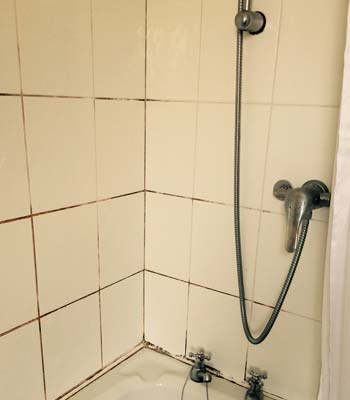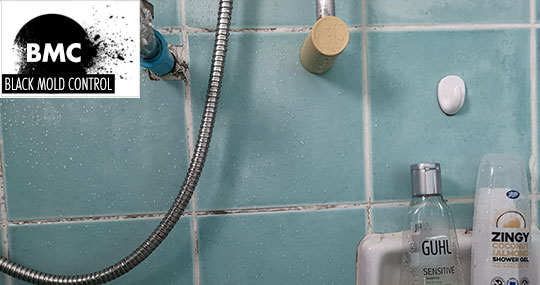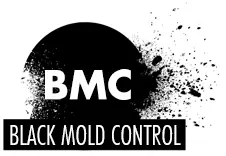The one place you do not want to find black mold is in your shower. The pesky nuisance can grow in any damp area and it is extremely hard to get rid of properly. It is recommended that you leave mold removal up to the professionals. Black fungus in your shower is unsanitary and should be removed as soon as possible because of health risks.
You may see black spores above your head growing on the ceiling, on the walls, the curtains and around your drain. It may have already gotten deep into your drywall and created structural problems. Once black spores take hold in any area, it can grow fast and spread.

Many people do not understand the health risks of black mold. Black spores thrive off of body oils, soap scum and hair. Professional removers have the techniques and the proper gear like goggles, and rubber gloves to clean up your home efficiently so that it will not affect your drywall and create more health risks to you and your family.
Table of contents
Is black mold in my shower dangerous?
Black mold in your shower can be extremely dangerous. You will be able to recognize black spores by its unpleasant slimy, green, gray, musty smell with an appearance of black in color. Any kind of bacteria or black fungus should be removed as soon as it can.
The fungus can cause structural damage to your bathroom. It can get under your wallpaper, carpets, wood, drywall and grow on your ceiling tiles. If left unchecked it will grow rapidly within 48 hours. You may not have the visual fungus in your bathroom, but you may smell a musty stink that you cannot locate.
It can be developing in your walls, within the ceiling, or under the floor. Only a professional can find the source of the black spores and the extent of the damages that it is doing in your home. This may be causing health risks to your family and the fungus should be killed off properly.
Read our article: is black mold dangerous?
How about: health risks?
Mold can affect your family’s breathing, destroy the immune system, inflame mucous membranes and cause headaches, sneezing, and extreme coughing. You may think that these signs are allergies acting up, but they are all signs of the fungus growing in your home creating health risks. The sneezing, wheezing, and trouble breathing is some of the first signs of fungus growing somewhere in your home.
There are many different kinds of bacteria’s that can grow in your home. Each one has its own level of toxicity, and almost all of them will create health risks. Many people will have skin irritations and lung problems from breathing in the spores. It can also bring on asthma attacks and make people feel extremely tired.
Types of mold in shower
There are several types of spores that grow in your shower and bathroom.
Pink
This is really a bacterium, and it is not a fungus. Its scientific name is Serratia marcescens. It is usually found in the bathroom. It grows very fast in damp, dark, wet places like the shower, on tiles, bathtubs, and the sink. Pink mold can cause gastrointestinal conditions, urinary tract, bladder, respiratory infections, and pneumonia and other conditions. How to get rid of the pink bacterium is easy. You can use bleach or a baking soda paste on the areas affected to kill the bacterium and then rinse thoroughly.
Red
Red bacteria or fungus can be anywhere from a pinkish to a bright orange or dark red. You will find it mostly on the bottom of your shower curtains and around the drain. How to get rid of red bacteria is simple. You can do it by bleaching the area or shower curtains and rinsing everything thoroughly.
Alternaria
This is typically found around the house where there is dampness. It is allergenic and is very common. It has a velvet-texture and has brown or dark green hairs. It grows on the ceiling, below sinks, bathtubs, or may show up where there has been water damage done to the home. It may even be in your drywall where you cannot see it. Removal of Alternaria should be taken care of right away. How to get rid of Alternaria is done by calling in a professional removal team who can do the job properly.
Black
Also, known as Stachybotrys, black mold, can also appear as a dark greenish color that has a slimy texture. It thrives in wet, damp, and high humidity areas. It grows on cardboard, paper, woods, hay, as well as walls, ceilings, tiles, and even wicker. Once it gets into your drywall, the drywall will need to be replaced. It is a health risk for many people when they breathe in the black spores. Removal of black decay in your home should be done by professionals.

How to get rid of mold in shower?
Bleach can help to kill most fungus and mildew, but if you are not cleaning with bleach on a regular basis then it will all return in a month or more. You can also use vinegar or Borax solutions in a spray bottle. You can spray the shower, and use a cleaning cloth to wipe the walls down.
After spraying the tiles and caulking you may need to take a toothbrush to get the tiles or caulking clean. If the caulk does not come clean, you may want to replace the caulking before you have the same problem again. Replacing the caulking may be the best idea on how to get rid of the mold in your shower.
Removal from shower drain
A good cleaner for the drain would be boiling water and a cup of white distilled vinegar poured down the drain. Immediately after that mixture has drained, pour a ½ cup of baking soda down the drain. This cleaner mixture should get rid of the black spores around and in the drain. Make sure your drain is in place properly by using some silicone to seal it up right.
If you are going to use bleach make sure you use a face mask, gloves and wear old clothes. This cleaner mixture should be 1-part bleach to 2 parts water. Spray the mixture on the molded drain and watch it start to disappear.
A good cleaner, along with a solid brush will help you get into all the holes of the drain. Make sure you ventilate the room well while cleaning with bleach because it could be dangerous to breathe into your system. This bleaching method may be good for the walls as well.
Removal from shower head
Cleaning a showerhead is not too time-consuming. One easy way is to fill a plastic bag with white vinegar and hot water. Place the shower head in the bag and tie it off. Let it soak overnight and clean it with warm water in the morning. Some silicone would seal your head up to stop any more decay from happening.
If you want to use baking soda, you can mix 1 cup of white vinegar with 1/3 cup of baking soda into a strong bag. Secure the bag onto the showerhead and leave it overnight. You may have to scrub it a bit to get rid of all the mildew or fungus.
Removal from shower tile and grout
You can use a steam cleaner, or baking soda and a coarse brush to clean the tiles and grout. You can also use a stiff brush with some bleach and leave it on the grout for 30 minutes or so. Rinse with warm water and repeat the steps until the black color is gone.
Some people use baking soda as a paste. Mix it with water and make a slightly thick paste. Put it on the grout and then pour hydrogen peroxide over the grout. Use a brush to clean the foamy paste off. You can also use distilled vinegar. Spray it on the grout and let it stand for 30 to 45 minutes. Take a brush to the grout and rinse.

Removal from shower door
Cleaning your shower door from mildew and or fungus is not hard. Make sure you ventilate your room before cleaning the door. You can use hydrogen peroxide or chlorine in a spray bottle and spray your door. Then wipe it down. You will not even have to scrub. Silicone sealant could keep the door from getting water seepage. The problem you might find is that the mildew has gotten behind the caulk or grout. If it does and it is really bad, you might have to replace the grout or caulking.
Removal from shower curtain
Your shower curtain is most likely made out of plastic. Take your curtain down and wash it with some towels. The towels will keep your curtains from crinkling and will be a scrubber for your curtains. Use ½ cup baking soda along with some of your detergent. When it comes to the rinse cycle, add a ½ cup of vinegar. Hang your curtains outside to dry. If the solution did not get into all the areas of the curtain, then repeat washing the curtains again. –>Read our in-depth article<--
Best shower mold cleaner and tools
Some of the best products to use are the RMR-86 Instant Mold Stain and Mildew Stain Remover Plus Mold Stain Blocker. This cleaner comes in a gallon size. It is simple and very quick to react to mildew and fungus stains. It will work within 15 seconds without any sanding, scrubbing or wire brushing.
The dual package of the Complete Mold Killer and Remover DIY Bundle, Clean and Prevent Mold and Mildew (1-32oz RMR86, 1-32 oz RMR-141 RTU and 2 Trigger sprayers), is a cleaner that will kill, and prevent mildew and fungus. The RMR-86 is the fastest mold stain remover and the RMR-141 kills and will prevent any mildew from coming back. The RMR-141 is easy to use. You can spray it on hard or porous surfaces.
How to prevent black mold in shower
If you squeegee down the walls, tiles, and door after your shower you will prevent three-fourth of the moisture in the room from soaking in and doing water damage. A fan will take moisture out of your bathroom. You should leave it running for about a half hour after you are finished.
When putting the head back up, it would be wise to seal it tightly with some silicone. Silicone will help to keep the water from getting behind the head and creating a dangerous fungus growth.
Hiring a mold remediation professional
No matter what caused the mold and mildew in your home, our technicians can fix the problems. We can use silicone to seal up windows and doors so no water can create any dangerous fungus from forming. We know how dangerous black mold is. Our professional removal specialists can give you a free mold inspection and bring your home back to normal. Give us a call, and we will set up a time that is best for you.
